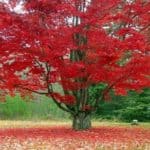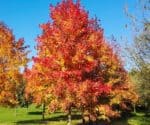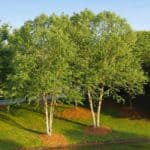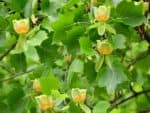The Most Common North Carolina Trees: An Identification Guide

The Most Common North Carolina Trees:
An Identification Guide
Did you know that the red maple, loblolly pine, and sweetgum trees are some of the most common trees in all of the United States? These trees, along with many others, make up the beautiful forests of North Carolina and can all be identified by their own unique characteristics.
Since you’ve clicked on this article, you’re undoubtedly interested in the most common North Carolina trees and how you can identify them. Maybe you live in North Carolina and would like to know about that tree in your backyard, or you’re a tree identification enthusiast. Whatever the case, you’re in the right place to find all your answers.
By the end of this article, you’ll be able to identify the trees in North Carolina with a mere glance. To start off, we’ll begin with one of the state’s most common and identifiable trees: the red maple.
Red Maple North Carolina Trees

Not only is it one of the most common trees in North Carolina, but it is the single most common tree in the United States. It would be hard not to spot a red maple tree no matter where you might be on the east coast. In fact, red maples are so common and grow so easily that some consider them to be an invasive species.
This is because, in some areas, red maples have pushed out other species of trees such as pines. The roots of red maples are very dense and widespread, making it difficult for other species of trees to grow too close. If you’re trying to grow a red maple, you won’t have much trouble!
Loblolly Pine Trees

Loblolly pines can grow to massive sizes. They often reach 5 feet around their trunks and can grow more than 100 feet high. They are also known to grow very fast and are evergreen.
So, how can you identify loblolly pines from other pines? More often than not, loblolly pines will be found in low, swampy areas with a lot of moisture.
Their needles are very long and can grow up to 10 inches. If you snap off some of these needles, they will have a very strong piney fragrance. The bark of loblolly pines is also quite characteristic in that it appears as hard, grey scales.
Sweetgum Trees

However, the easiest way to recognize sweetgum trees is by their unique fruit known as burrs. These burrs are full of seeds and very spikey. They are often annoying to those who have sweetgum trees on their property because of the way these burrs can stick to clothing and even skin.
The trunks of sweetgum trees can reach 4 feet around and the height can range up to 120 feet. Similar to loblolly pines, sweetgum trees are usually found in wet, swampy areas. In fact, sweetgum trees may even thrive in areas that flood.
The bark of the sweetgum tree has deep ridges on it. The trunks of these trees are also very straight and the wood these trees produce has value in the lumber industry.
River Birch Trees

For the same reason, these trees don’t do well during periods of drought. If river birch trees don’t get enough water, you will notice their leaves will start to turn yellow and fall off.
Birch trees can grow to 300 feet in height though their trunks remain thin. The most distinguishing characteristic of birch trees is their bark. Unlike other trees that have hard, dense bark, birch trees have grey, papery bark that you can peel off with your hands.
If you are trying to grow river birch trees, be sure that your soil doesn’t drain too much. Birch trees will only thrive in soil that retains water.
Yellow Poplar Trees

They grow so fast that their wood is rendered weaker than other trees. Yellow poplars also have common problems with pests and don’t like to grow in cramped areas. Because of these factors, growing yellow poplars can be difficult.
The Trees of North Carolina
You now know about some of the most common North Carolina trees and how to identify them. You also know where these trees might be found and how you might care for them!
If you want your property to embody the beauty of North Carolina’s forests, you can tell which trees might be able to thrive on your property and which might not. If you’re still unsure, tree care services are always available to help.
To learn more about trees and tree services, contact us here.



You must be logged in to post a comment.